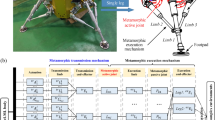Abstract
The lander has made a significant contribution to soft landings and exploration of an extraterrestrial surface. To further expand its detection range and meet the needs of base construction in the future, it is necessary to design a legged mobile lander (LML) that lets the fixed lander walk. In this paper, a decoupled functions synthesis method (DFSM), which means the decoupled landing and walking functions for LMLs, is proposed: it uses separate structures of landing leg (LL) and walking leg (WL) to perform landing and walking functions. The structure of the Chang’e lander’s leg is selected and designed as the LL. The structures of WLs are determined and presented by the Lie group type synthesis method. In accordance with the combination principle, the landing-walking leg (LWL) for LMLs is designed by combining the structures of a LL and a WL. The structures of a family of LMLs are achieved by assembling the same or different structures of legs. Furthermore, the actuated joints are assigned according to the principle for selecting the actuated joint and one case of LWL is selected as an optimized type by the qualitative evaluation. Finally, one leg of LMLs is taken as an example to analyze the properties and abilities during different stages.
Similar content being viewed by others
References
B. B. Donahue, G. Caplin, D. B. Smith, J. W. Behrens and C. Maulsby, Lunar lander concepts for human exploration, Journal of Spacecraft and Rockets, 45 (2008) 383–393.
B. Hapke, Surveyor I and Luna IX pictures and the Lunar soil, Icarus, 6 (1967) 254–269.
R. J. Williams and E. K. Gibson, The origin and stability of lunar goethite, hematite and magnetite, Earth and Planetary Science Letters, 17 (1972) 84–88.
S. P. Weiss, Apollo Experience Report: Lunar Module Structural Subsystem, NASA-TN-D-7084, NASA, USA (1973).
R. Parkinson, The use of system models in the EuroMoon spacecraft design, Acta Astronautica, 44 (1999) 437–443.
T. Okada et al., Lander and rover exploration on the lunar surface: A study for SELENE-B mission, Advances in Space Research, 37 (2006) 88–92.
L. J. Prinzel III et al., Synthetic and enhanced vision system for Altair Lunar lander, Proc. of the 2009 International Symposium on Aviation Psychology (2009) 660–665.
W. Wu and D. Yu, Key technologies in the Chang’E-3 soft-landing project, J. Deep Space Explor., 1 (2014) 105–109.
L. Lu, Z. Zhixian, G. Linli, Y. Chen, Z. Yao, L. Min and Y. Peijian, Mobile lunar lander crewed lunar exploration missions, Manned Spaceflight, 21 (5}) (2015}) 472–.
R. Lin, W. Guo, M. Li, Y. Hu and Y. Han, Novel design of a legged mobile lander for extraterrestrial planet exploration, International Journal of Advanced Robotic Systems, 14 (6) (2017) 172988141774612.
R. Lin et al., Type synthesis of legged mobile landers with one passive limb using the singularity property, Robotica, 36 (12) (2018) 1836–1856.
R. Lin, W. Guo and M. Li, Novel design of legged mobile landers with decoupled landing and walking functions containing a rhombus joint, Journal of Mechanisms and Robotics, 10 (6) (2018) 061017.
Y. Pan and F. Gao, Leg kinematic analysis and prototype experiments of walking-operating multifunctional hexapod robot, Proceedings of the Institution of Mechanical Engineers, Part C: J. of Mechanical Engineering Science, 228 (2014) 2217–223.
Q. Li and J. M. Hervé, Type synthesis of 3-DOF RPR-equivalent parallel mechanisms, IEEE Transactions on Robotics, 30 (6) (2017) 1333–1343.
R. Lin, W. Guo and F. Gao, Type synthesis of a family of novel 4-, 5- and 6-DOF sea lion ball mechanisms with three limbs, J. of Mechanisms & Robotics, 8 (2015).
F. Gao, W. Li, X. Zhao, Z. Jin and H. Zhao, New kinematic structures for 2-, 3-, 4-, and 5-DOF parallel manipulator designs, Mechanism & Machine Theory, 37 (2002) 1395–1411.
W. Bu et al., Mobility analysis for parallel manipulators based on intersection of screw manifolds, Journal of Mechanical Science and Technology, 30 (9) (2016) 4345–4352.
M. H. Lucy, R. D. Buehrle and J. P. Woolley, Comparison of Separation Shock for Explosive and Nonexplosive Release Actuators on a Small Spacecraft Panel, No. NASA-TM-110257, National Aeronautics and Space Administration, Hampton, Virginia, Langley Research Center} (199.
H. Zhao et al., Numerical study on separation shock characteristics of pyrotechnic separation nuts, Acta Astronautica, 151 (2018) 893–903.
Acknowledgments
The work was supported by the National Natural Science Foundation of China (Grant No. 51735009, 51905338) and the China Postdoctoral Science Foundation (Grant No. 2019M651487).
Author information
Authors and Affiliations
Corresponding author
Additional information
Rongfu Lin is currently a Post Doctor at State Key Laboratory of Mechanical Systems and Vibration, Shanghai Jiao Tong University, China. His research interests include parallel mechanisms, biomimetic robots.
Weizhong Guo is currently a Professor at State Key Laboratory of Mechanical System and Vibration, Shanghai Jiao Tong University, China. His research interests include controllable mechanisms, parallel kinematic mechanisms.
Rights and permissions
About this article
Cite this article
Lin, R., Guo, W. Novel design of a family of legged mobile landers based on decoupled landing and walking functions. J Mech Sci Technol 34, 3815–3822 (2020). https://doi.org/10.1007/s12206-020-0832-x
Received:
Revised:
Accepted:
Published:
Issue Date:
DOI: https://doi.org/10.1007/s12206-020-0832-x




